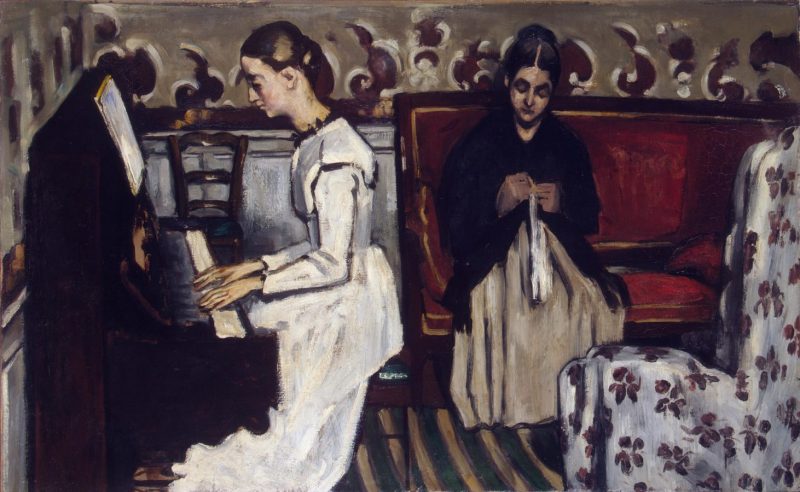Painting music or listening to pictures: Wagnerism in Art
By Alina Manevskaya
What is Wagnerism? There are no other cultural movements in the world that were named after one person. Wagnerism was an admiration to Wagner’s musical oeuvre that originated in the second half of the nineteenth century. The attention, directed at his music was so huge, that the habits of the audience that listened to it had to be changed from demonstrating their dresses in theatres to listening to the performance with as much attention as possible.

Henri Fantin-Latour. Around the Piano (1885). Musee d’Orsay.
There are some artworks that represent different types of listening to Wagner’s music. The first one is called “Around the piano”. It was painted by Henri Fantin-Latour in 1885. In this painting we can see a group of people, listening to music. All of them were musicians, and all of them were Wagnerians. Despite the absence of a Wagnerian title or any reference to Wagner, this picture was considered to be Wagnerian right from the very beginning, as all the depicted musicians were great admirers of Wagner’s music, and the music that they are listening to in the picture is also probably Wagner’s music.
If we look at Aubrey Beardsley’s drawing “The Wagnerites”, we will see a different kind of Wagnerian listener. The drawing depicts an audience of women listening to Wagner’s opera “Tristan’s and Isolde”. All of them are sitting in the stalls, that were considered to be places for lower-class audience, and all of them are wearing open dresses in order to attract men’s attention while listening to the opera about love.

Aubrey Beardsley. The Wagnerites (1894). The V&A Museum.
Paul Cezanne’s Overture to Tannhäuser is a completely different Wagnerian picture. The women, depicted in the picture, are the artist’s mother and sister. While one of them is playing the piano, another one is sewing. We may assume, that the picture represents two different worlds of a dream: while the artist’s sister is dreaming of an artistic life, his mother is submerged by daily activities of an ordinary woman.

Paul Cezanne. Overture to Tannhäuser (1869). State Hermitage, Saint-Petersburg.
Another Wagnerian painting is also concerned with Wagner’s controversial opera Tannhäuser. While Cezanne’s painting represents the difference between the world of dreams of two women, Edouard Manet’s “Music in the Tuileries” painting, which is a group portrait of many cultural personalities of the nineteenth century, is a tribute to Wagner by means of applying his new operatic ideas to pictorial space. In his operas, Richard Wagner tried to overcome the structure of the musical piece by erasing the borders between arias, duets and and other musical numbers within the whole piece. He wanted his operas to be a single whole, undivided into separate units. This is what Manet is doing in the painting. The crowd of people is pushing itself through the space, as if trying to overcome the borders, created by the trees. The only figure, who is not involved in the process of pushing, and who is painted separately is a French composer Jacques Offenbach, depicted in the background of the tree on the right side of the painting. This is because he didn’t share Wagnerian ideas and stood on his own in the world of music.

Edouard Manet. Music at the Tuileries (1862). On loan to the National Gallery, London.
Unlike his fellow artists, Seurat has never depicted a Wagnerian subject. However, his art may also be considered Wagnerian. In the picture, entitled “Le Chahut” ( the word may be translated as “uproar” or “noise”), which represents a can-can, a sexual dance, performed in Paris, the Wagnerian message is conveyed by means of frame. The artists wanted the painting to be exhibited in a dark framed to emphasise the difference between the dark audience and the brightly lit stage. This was the effect, introduced by Wagner in his purpose-built festival theatre in Bayreuth. In the second half of the nineteenth century, when the revolutionary effects of Wagner’s music became evident in theatres, the methods of darkening the auditorium during the performance were devised in Bayreuth in order to prevent a listener from being distracted by the appearance and movements of others in the audience. As the purpose of the visit to an ordinary opera house before Wagner’s decision to darken the audience was to socialise, to observe and to be observed, Wagner’s decision to darken the auditorium in order for the audience to concentrate on the performance was a revolutionary idea of his time. And if we assume that the subject of Seurat’s painting is taking place onstage, we may see that Seurat is doing the same as Wagner by darkening the frame, identified as the audience, and brightening the pictorial space, identified as the stage.

Georges Seurat. Le Chahut (1889-1890). Kröller-Müller Museum, Otterlo.
In conclusion I’d like to say, that there are different representations of listening to Wagner’s music and different Wagnerian pictures. If Fantin-Latour, Cezanne and Beardsley represented people, listening to Wagner’s music, Manet’s task was to combine the depiction of Wagnerian listening with a pictorial equivalent to his operatic innovations, while Seurat’s Wagnerism was exhibited by separating the pictorial space from the auditorium by means of darkening the frame and lighting the painted stage.
